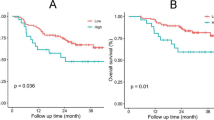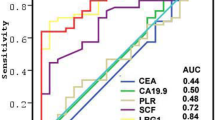Abstract
Background
Early diagnosis and treatment are crucial to improve the prognosis of colorectal cancer (CRC). At present, there is a lack of an accurate CRC screening factor. We conducted folate receptor-positive circulating tumor cell analysis (FR + CTC analysis) in distinguishing CRC from benign colorectal diseases to evaluate the diagnostic efficiency.
Methods
Clinical data of patients admitted to The First Affiliated Hospital of Anhui Medical University from January 2021 to July 2022 were retrospectively collected. Levels of FR + CTC and other indicators were analyzed. Receiver operating characteristic (ROC) analysis was performed to assess the diagnostic performance of these molecular biomarkers.
Results
Data of 103 patients with CRC and 54 patients with benign colorectal diseases were collected. FR + CTC levels were observed significantly higher in CRC patients than in patients with benign colorectal diseases (P < 0.001). FR + CTC level was correlated with tumor diameter, differentiation, T-stage, pathological stage, clinical stage, and intravascular tumor thrombus in patients with CRC (P < 0.05). The optimal cutoff value of FR + CTC level for diagnosing CRC patients was 7.66 FU/3 ml, with a sensitivity of 85.4%, a specificity of 74.1%, and an Area Under Curve (AUC) of 0.855 (95% CI 0.77–0.923). In < 50-years old patients with CRC, the diagnostic efficiency of FR + CTC was excellent, with an AUC of 0.936 (95% CI 0.877–0.995).
Conclusion
FR + CTC counting has excellent diagnostic efficiency in screening of CRC. FR + CTC count can also predict the tumor stage of CRC patients before surgery, and guide the choice of treatment.







Similar content being viewed by others
Data availability
The data that support the findings of this study are available from the corresponding author upon reasonable request.
References
Sung H, Ferlay J, Siegel RL et al (2021) Global Cancer Statistics 2020: GLOBOCAN Estimates of Incidence and Mortality Worldwide for 36 Cancers in 185 Countries. CA Cancer J Clin 71(3):209–249
Li J, Dittmar RL, Xia S et al (2017) Cell-free DNA copy number variations in plasma from colorectal cancer patients. Mol Oncol 11(8):1099–1111
Mannath J, Ragunath K (2011) Endoscopic mucosal resection: who and how? Therap Adv Gastroenterol 4(5):275–282
D’souza N, Georgiou Delisle T, Chen M et al (2021) Faecal immunochemical test is superior to symptoms in predicting pathology in patients with suspected colorectal cancer symptoms referred on a 2WW pathway: a diagnostic accuracy study. Gut 70(6):1130–1138
Gorges TM, Tinhofer I, Drosch M et al (2012) Circulating tumour cells escape from EpCAM-based detection due to epithelial-to-mesenchymal transition. BMC Cancer 12:178
Nawaz FZ, Kipreos ET (2022) Emerging roles for folate receptor FOLR1 in signaling and cancer. Trends Endocrinol Metab 33(3):159–174
Varaganti P, Buddolla V, Lakshmi BA et al (2023) Recent advances in using folate receptor 1 (FOLR1) for cancer diagnosis and treatment, with an emphasis on cancers that affect women. Life Sci 326:121802
Cheng H, He W, Yang J et al (2020) Ligand-targeted polymerase chain reaction for the detection of folate receptor-positive circulating tumour cells as a potential diagnostic biomarker for pancreatic cancer. Cell Prolif 53(9):e12880
Maly V, Maly O, Kolostova K et al (2019) Circulating tumor cells in diagnosis and treatment of lung cancer. In Vivo 33(4):1027–1037
Shia J, Klimstra DS, Nitzkorski JR et al (2008) Immunohistochemical expression of folate receptor alpha in colorectal carcinoma: patterns and biological significance. Hum Pathol 39(4):498–505
Tsai WS, You JF, Hung HY et al (2019) Novel circulating tumor cell assay for detection of colorectal adenomas and cancer. Clin Transl Gastroenterol 10(10):e00088
Oh BY, Kim J, Lee WY et al (2017) A new size-based platform for circulating tumor cell detection in colorectal cancer patients. Clin Colorectal Cancer 16(3):214–219
Binefa G, Rodríguez-Moranta F, Teule A et al (2014) Colorectal cancer: from prevention to personalized medicine. World J Gastroenterol 20(22):6786–6808
Shaukat A, Levin TR (2022) Current and future colorectal cancer screening strategies. Nat Rev Gastroenterol Hepatol 19(8):521–531
Sega EI, Low PS (2008) Tumor detection using folate receptor-targeted imaging agents. Cancer Metastasis Rev 27(4):655–664
Yan S, Guo W, Liu Y et al (2022) The role of folate receptor-positive circulating tumor cell analysis in the diagnosis of colorectal cancer: a retrospective cohort study. Int J Clin Oncol 27(3):538–544
Chang JC, Kundranda M (2017) Novel diagnostic and predictive biomarkers in pancreatic adenocarcinoma. Int J Mol Sci 18(3):667
Tsen A, Barbara M, Rosenkranz L (2018) Dilemma of elevated CA 19–9 in biliary pathology. Pancreatology 18(8):862–867
Pavai S, Yap SF (2003) The clinical significance of elevated levels of serum CA 19–9. Med J Malaysia 58(5):667–672
Baek DH, Kim GH, Song GA et al (2019) Clinical potential of circulating tumor cells in colorectal cancer: a prospective study. Clin Transl Gastroenterol 10(7):e00055
Cohen SJ, Punt CJ, Iannotti N et al (2009) Prognostic significance of circulating tumor cells in patients with metastatic colorectal cancer. Ann Oncol 20(7):1223–1229
Tol J, Koopman M, Miller MC et al (2010) Circulating tumour cells early predict progression-free and overall survival in advanced colorectal cancer patients treated with chemotherapy and targeted agents. Ann Oncol 21(5):1006–1012
Bork U, Rahbari NN, Schölch S et al (2015) Circulating tumour cells and outcome in non-metastatic colorectal cancer: a prospective study. Br J Cancer 112(8):1306–1313
Crawshaw BP, Chien HL, Augestad KM et al (2015) Effect of laparoscopic surgery on health care utilization and costs in patients who undergo colectomy. JAMA Surg 150(5):410–415
Veldkamp R, Kuhry E, Hop WC et al (2005) Laparoscopic surgery versus open surgery for colon cancer: short-term outcomes of a randomised trial. Lancet Oncol 6(7):477–484
Buunen M, Veldkamp R, Hop WC et al (2009) Survival after laparoscopic surgery versus open surgery for colon cancer: long-term outcome of a randomised clinical trial. Lancet Oncol 10(1):44–52
Funding
This work was supported by the Anhui Provincial Key Research and Development Project under Grant (202104j07020029);
Author information
Authors and Affiliations
Contributions
B-cZ and Z-jW made the contribution to the main work equally. Conception and design: B-cZ and Z-jW. Administrative support: A-mX. Provision of study materials or patients: All authors. Collection and assembly of data: B-cZ and Z-jW. Data analysis and interpretation: B-cZ and G-xW. Manuscript writing: all authors. Final approval of manuscript: all authors.
Corresponding authors
Ethics declarations
Conflict of interest
The authors report there are no competing interests to declare.
Ethics statement
Our study was reviewed and approved by the Ethics Committee of the First Affiliated Hospital of Anhui Medical University.
Consent of publication
Written informed consent was obtained from the authors for the publication of any potentially identifiable images or data included in our manuscript.
Additional information
Publisher's Note
Springer Nature remains neutral with regard to jurisdictional claims in published maps and institutional affiliations.
Supplementary Information
Below is the link to the electronic supplementary material.
About this article
Cite this article
Wei, Zj., Zhou, Bc., Wang, Gx. et al. Diagnosis of colorectal cancer based on folate receptor-positive circulating tumor cell analysis: a retrospective cohort study. Int J Clin Oncol 29, 149–158 (2024). https://doi.org/10.1007/s10147-023-02435-6
Received:
Accepted:
Published:
Issue Date:
DOI: https://doi.org/10.1007/s10147-023-02435-6




